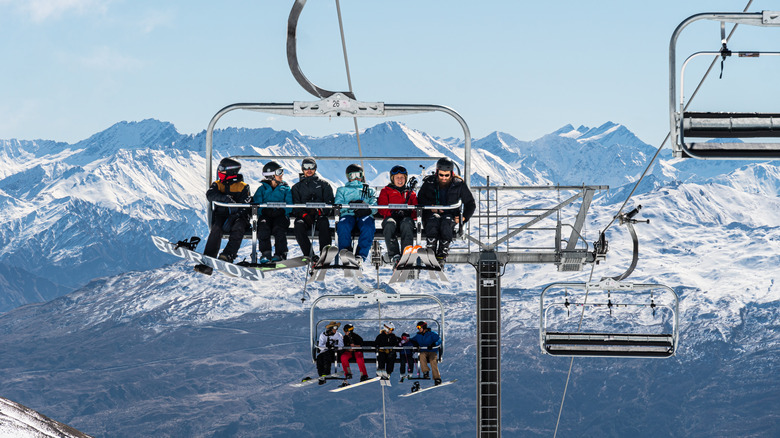The New Zealand Mountain Town Set To Become The World's First Zero-Carbon Ski Destination
The adventure capital of the world is located on a long, narrow island nation that's just one of the thousand comprising the beautiful Polynesian islands. You may know this South Pacific island better as New Zealand. It also happens to be one of the safest and most mesmerizing islands in the world. While New Zealand is actually made up of two distinct main islands — the North Island and the South Island — the nation can lay claim to more than 600 islands in total.
Whether you're seeking to dive deeper into New Zealand's rich Māori heritage, sip and savor world-class wines at countless vineyards, take an obligatory "Lord of the Rings" sightseeing tour, or simply live like a Kiwi in a nation where sheep vastly outnumber humans (approximately 4.6 to one, actually) — New Zealand won't disappoint.
However, a high-priority item on most travelers' minds when they come to New Zealand is adventure. And that adventure capital mentioned before? That's Queenstown. Nestled on the shores of Lake Wakatipu and enveloped by the soaring Southern Alps, Queenstown is taking bold to a new level. The town has an ambitious, jaw-dropping goal: To be a zero-carbon visitor economy by 2030. And that sustainability will greatly impact one of the town's biggest draws — its snowy slopes.
What spurred Queenstown to go zero-carbon
Queenstown's aspirational goal of leaning into regenerative tourism and creating a zero-carbon community in just six years is admirable yet audacious. But seeing as Queenstown, a small enclave on New Zealand's picturesque South Island with a population of just 50,000, welcomed nearly 400,000 visitors last year (greater than pre-pandemic levels), three local tourism organizations decided something needed to be done regarding sustainability. In 2021, Destination Queenstown, Queenstown Lakes District Council, and Lake Wanaka Tourism proposed the start of their decarbonization movement.
What's unique about Queenstown's proposal is that they are zeroing in on, well, zero carbon. This is much harder to achieve than carbon neutrality, which is often achieved by offsetting (not eliminating) carbon emissions with various methods or carbon credits. In March of 2023, the tourism organizations of Queenstown published a discussion paper outlining their initial findings, including interviews with carbon experts and government officials, to set out a roadmap for future decarbonization plans. The town's timeline and progress can be viewed on its new regenerative tourism website.
Skiing Queenstown's sustainable slopes
While much of the town's decarbonization plan focuses on local accommodations transitioning to more sustainable methods like running on alternative energy and composting waste, the surrounding ski resorts will also be getting a planet-friendly makeover. Electric-powered lift, anyone? You'll eventually be riding those at the area's four popular resorts: Cardrona Alpine, Coronet Peak, The Remarkables, and Treble Cone. And here's some great news for North Americans who would love to spend the whole year on fresh powder: Summer is ski season in New Zealand (typically running from June to October).
NZSki, which operates Coronet Peak and The Remarkables, is getting a head start. They announced in 2023 that they would be cutting their carbon emissions in half that year. Their three resorts (including Mt. Hutt a few hours north) previously emitted about 3,000 tonnes of carbon annually, primarily from their reliance on diesel fuel. The operator has already committed to using a hybrid snow groomer, sourcing 100% renewable power from partner Meridian Energy, purchasing carbon credits for native vegetation blocks in nearby Otago, and reducing waste and single-use plastic in its cafes.


